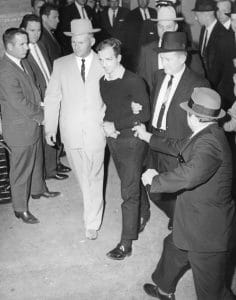Born and raised in Texas, Leavelle joined the U.S. Navy when he graduated high school in 1939. He was a sailor on the destroyer USS Whitney …and it was stationed at Pearl Harbor, Hawaii. Leavelle was aboard the ship, which was among a flotilla of five other destroyers in the harbor, but none of them were damaged in the attack that brought the U.S. into World War II. After the war, Leavelle worked for the Veterans Administration, and in 1950 joined the Dallas Police Dept., and was promoted to detective in 1956. On November 24, 1963, Leavelle was given an assignment to transfer a prisoner from the police station to the county jail. Leavelle handcuffed the prisoner to himself; on the other side was another detective, L.C. Graves. The prisoner’s name: Lee Harvey Oswald, who two days before had killed J.D. Tippit, a Dallas police officer, not to mention the president, John F. Kennedy. Leavelle was more concerned with the former crime: “What some people don’t realize is that when a police officer gets killed, that takes precedence over the shooting of the president, because that’s close to home.”

As Leavelle and Graves led Oswald through the police station’s basement, reporters crowded the scene to get the scoop. NBC was broadcasting it live. Leavelle said to Oswald, “Lee, if anybody shoots at you, I hope they’re as good a shot as you are,” demonstrating the tense atmosphere. “You’re being melodramatic,” Oswald replied. “Nobody’s going to shoot at me.” You’ve probably seen the Dallas Times Herald photograph by Robert H. Jackson taken milliseconds after Oswald was shot in the abdomen by Jack Ruby, a Dallas nightclub owner: it won the Pulitzer Prize, and Leavelle is notable in that he is wearing a tan suit and matching Stetson, in stark contrast to other detectives’ (and reporters’) black suits and hats. But you may not have seen the Dallas Morning News photograph by Ira Jefferson “Jack” Beers Jr., taken milliseconds before the shot rang out.
Leavelle tried to protect his prisoner by pulling Oswald behind him, but it was too late. Det. Graves, meanwhile, grabbed Ruby’s gun by the cylinder, keeping Ruby from firing it again. “I could see Ruby’s fingers flexing on the trigger,” Leavelle said later, “trying to fire.” He rode with Oswald in the ambulance to the same hospital where Kennedy was pronounced dead; he said he heard Oswald’s last breath along the way. Leavelle retired from Dallas P.D. in 1975, and spent much of his time giving speeches to recount the story of Oswald’s death. In 2018, he said he was still receiving about 500 requests for his autograph every year. He lived alone without assistance until this January. While on vacation in Denver, Colo., he injured his hip, and died on August 29 from a heart attack after surgery to repair it. He had turned 99 just six days earlier.
